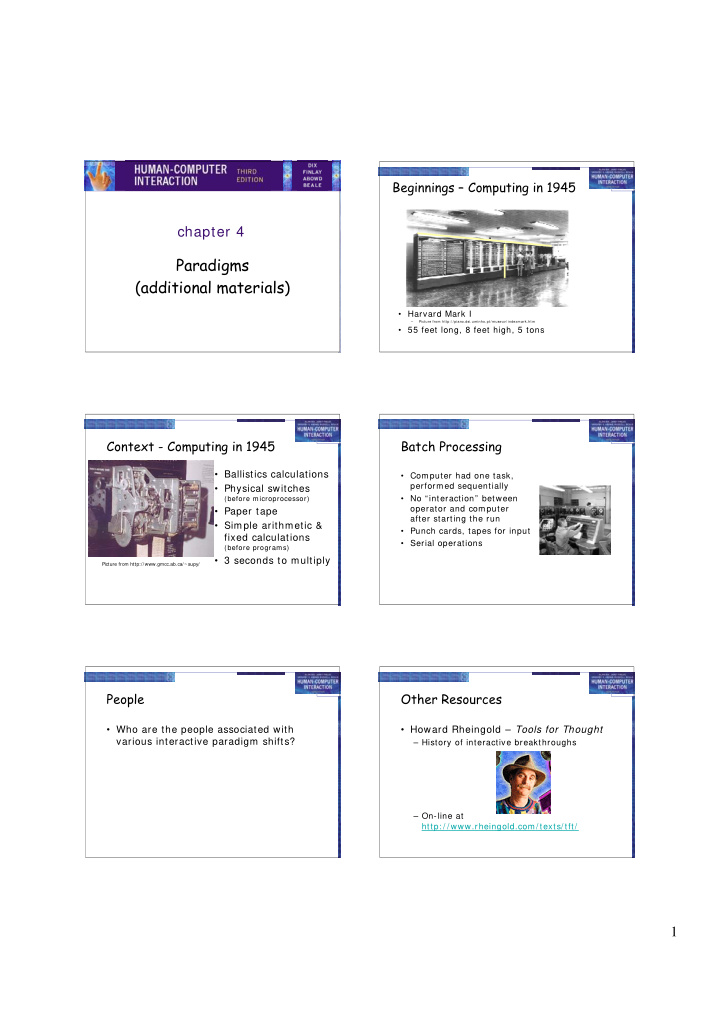



Beginnings – Computing in 1945 chapter 4 Paradigms (additional materials) • Harvard Mark I – Picture from http: / / piano.dsi.u m inho. pt/ m useuv/ indexm ark.htm • 55 feet long, 8 feet high, 5 tons Context - Computing in 1945 Batch Processing • Ballistics calculations • Computer had one task, performed sequentially • Physical switches (before m icroprocessor) • No “interaction” between operator and computer • Paper tape after starting the run • Simple arithmetic & • Punch cards, tapes for input fixed calculations • Serial operations (before program s) • 3 seconds to multiply Picture from http://www.gmcc.ab.ca/~ supy/ People Other Resources • Who are the people associated with • Howard Rheingold – Tools for Thought various interactive paradigm shifts? – History of interactive breakthroughs – On-line at http: / / www.rheingold.com/ texts/ tft/ 1
Innovator: Vannevar Bush More About Vannevar Bush • “As We May Think” - 1945 Atlantic Monthly • Name rhymes with "Beaver" – “… publication has been extended far beyond our present ability to make real use of the record.” • Faculty member MIT • Postulated M em ex device • Coordinated WWII effort with – Stores all records/ articles/ communications – Items retrieved by indexing, keywords, cross 6000 US scientists references (now called hyperlinks) – (Envisioned as microfilm, not computer) • Social contract for science • I nteractive and nonlinear com ponents are key – federal governm ent funds universities • http: / / www.theatlantic.com / unbound/ flashbks/ com puter/ b ushf.htm – universities do basic research – research helps econom y & national defense Innovator: J. R. Licklider Innovator: Ivan Sutherland • SketchPad - 1963 PhD thesis at MIT • 1960 - Postulated “m an-computer sym biosis” – Hierarchy - pictures & subpictures – Master picture with instances (ie, OOP) – Constraints • Couple human brains and computing machines – Icons tightly to revolutionize – Copying inform ation handling – Light pen input device – Recursive operations Innovator: Douglas Englebart About Doug Engelbart • Graduate of Berkeley (EE '55) • Landmark system/ demo: – "bi-stable gaseous plasm a digital devices" – hierarchical hypertext, m ultim edia, m ouse, • Stanford Research Institute (SRI) high-res display, windows, shared files, – Augm entation Research Center electronic messaging, CSCW, • 1962 Paper "Conceptual Model for Augmenting teleconferencing, ... Hum an Intellect" – Com plexity of problem s increasing – Need better ways of solving problem s Inventor of mouse Picture of Engelbart from bootstrap.org 2
Innovator: Alan Kay Innovator: Ben Shneiderman • Dynabook - Notebook sized computer loaded • Coins and explores notion of direct with multimedia and can store everything manipulation of interface • @PARC • Long-time Director of • Personal HCI Lab at Maryland com puting • Desktop interface • Overlapping windows Innovator: Nicholas Negroponte Innovator: Ted Nelson • Computers can help people, not just • MIT Architecture Machine Group business – ’69-’80s - prior to Media Lab • Ideas – wall-sized displays, video • Coined term disks, AI in interfaces “hypertext” (agents), speech recognition, m ultim edia with hypertext – Put That There (Video) Innovator: Mark Weiser • Introduced notion of Ubiquitous Computing and Calm Technology – It’s everywhere, but recedes quietly into background • CTO of Xerox PARC 3
Recommend
More recommend